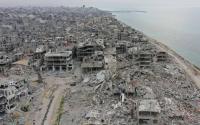Common Dreams / Published on Thursday, September 1, 2005 by Knight-RidderSeth Borenstein
The federal government so far has bungled the job of quickly helping the multitudes of hungry, thirsty and desperate victims of Hurricane Katrina, former top federal, state and local disaster chiefs said Wednesday.
The experts, including a former Bush administration disaster response manager, told Knight Ridder that the government wasn't prepared, scrimped on storm spending and shifted its attention from dealing with natural disasters to fighting the global war on terrorism.
The disaster preparedness agency at the center of the relief effort is the Federal Emergency Management Agency (FEMA), which was enveloped by the new Department of Homeland Security with a new mission aimed at responding to the attacks of al-Qaida.
"What you're seeing is revealing weaknesses in the state, local and federal levels," said Eric Tolbert, who until February was FEMA's disaster response chief. "All three levels have been weakened. They've been weakened by diversion into terrorism."
In interviews on Wednesday, several men and women who've led relief efforts for dozens of killer hurricanes, tornadoes and earthquakes over the years chastised current disaster leaders for forgetting the simple Boy Scout motto: Be Prepared.
Bush administration officials said they're proud of their efforts. Their first efforts emphasized rooftop rescues over providing food and water for already safe victims.
"We are extremely pleased with the response of every element of the federal government (and) all of our federal partners have made to this terrible tragedy," Secretary of Homeland Security Michael Chertoff said during a news conference Wednesday in Washington.
The agency has more than 1,700 truckloads of water, meals, tents, generators and other supplies ready to go in, Chertoff said. Federal health officials have started setting up at least 40 medical shelters. The Coast Guard reports rescuing more than 1,200 people.
But residents, especially in Biloxi, Miss., said they aren't seeing the promised help, and Knight Ridder reporters along the Gulf Coast said they saw little visible federal relief efforts, other than search-and-rescue teams. Some help started arriving Wednesday by the truckloads, but not everywhere.
"We're not getting any help yet," said Biloxi Fire Department Battalion Chief Joe Boney. "We need water. We need ice. I've been told it's coming, but we've got people in shelters who haven't had a drink since the storm."
The slow response to Katrina and poor federal leadership is a replay of 1992's mishandling of Hurricane Andrew, said former FEMA chief of staff Jane Bullock, a 22-year veteran of the agency.
Bullock blamed inexperienced federal leadership. She noted that Chertoff and FEMA Director Michael Brown had no disaster experience before they were appointed to their jobs.
The slowness is all too familiar to Kate Hale. As Miami's disaster chief during Hurricane Andrew, Hale asked: "Where the hell's the cavalry?"
"I'm looking at people who are begging for ice and water and (a) presence," Hale said Wednesday. "I'm seeing the same sort of thing that horrified us after Hurricane Andrew. ... I realize they've got a huge job. Nobody understands better than I do what they're trying to respond to, but ..."
Budget cuts haven't made disaster preparedness any easier.
Last year, FEMA spent $250,000 to conduct an eight-day hurricane drill for a mock killer storm hitting New Orleans. Some 250 emergency officials attended. Many of the scenarios now playing out, including a helicopter evacuation of the Superdome, were discussed in that drill for a fictional storm named Pam.
This year, the group was to design a plan to fix such unresolved problems as evacuating sick and injured people from the Superdome and housing tens of thousands of stranded citizens.
Funding for that planning was cut, said Tolbert, the former FEMA disaster response director.
"A lot of good was done, but it just wasn't finished," said Tolbert, who was the disaster chief for the state of North Carolina. "I don't know if it would have saved more lives. It would have made the response faster. You might say it would have saved lives."
FEMA wasn't alone in cutting hurricane spending in New Orleans and the surrounding area.
Federal flood control spending for southeastern Louisiana has been chopped from $69 million in 2001 to $36.5 million in 2005, according to budget documents. Federal hurricane protection for the Lake Pontchartrain vicinity in the Army Corps of Engineers' budget dropped from $14.25 million in 2002 to $5.7 million this year. Louisiana Democratic Sen. Mary Landrieu requested $27 million this year.
Both the New Orleans Times-Picayune newspaper and a local business magazine reported that the effects of the budget cuts at the Army Corps of Engineers were severe.
In 2004, the Corps essentially stopped major work on the now-breached levee system that had protected New Orleans from flooding. It was the first such stoppage in 37 years, the Times-Picayune reported.
"It appears that the money has been moved in the president's budget to handle homeland security and the war in Iraq, and I suppose that's the price we pay," Jefferson Parish emergency management chief Walter Maestri told the newspaper. "Nobody locally is happy that the levees can't be finished, and we are doing everything we can to make the case that this is a security issue for us."
The Army Corps' New Orleans office, facing a $71 million cut, also eliminated funds to pay for a study on how to protect the Crescent City from a Category 5 storm, New Orleans City Business reported in June.
Being prepared for a disaster is basic emergency management, disaster experts say.
For example, in the 1990s, in planning for a New Orleans nightmare scenario, the federal government figured it would pre-deploy nearby ships with pumps to remove water from the below-sea-level city and have hospital ships nearby, said James Lee Witt, who was FEMA director under President Clinton.
Federal officials said a hospital ship would leave from Baltimore on Friday.
"These things need to be planned and prepared for; it just doesn't look like it was," said Witt, a former Arkansas disaster chief who won bipartisan praise on Capitol Hill during his tenure.
FEMA said some of its response teams were prepared.
The agency had 18 search-and-rescue teams and 39 disaster medical teams positioned outside storm areas and moved them in when the hurricane died down.
Nonetheless, victims of this week's hurricane should have gotten more, said John Copenhaver, a former southeastern regional FEMA director.
"I would have difficulty explaining why there has not been a visible presence of ice, water, tarps - the kind of stuff that typically get delivered to hurricane areas," Copenhaver said.
A FEMA spokesman, James McIntyre, blamed the devastation in the region for slowing down relief efforts.
Roads were washed out and relief trucks were stopped by state police trying to keep people out of hazardous areas, he said.
That explanation didn't satisfy Joe Myers, Florida's former emergency management chief.
"I would think that yesterday they could have flown in," said Myers. "Everyone was flying in. Put it this way, FOX and CNN are there. If they can get there ..."
FEMA moved quickly with its search-and-rescue teams, which took precedence over delivering water and ice, McIntyre said.
"We're trying to save lives," McIntyre said. "The rescue teams are FEMA people. The medical assistance are FEMA people. Right now, getting people off roofs and keeping people from drowning are a priority."
Further complicating the relief effort in Louisiana is scandal within the state agency. Recently, three top officials of Louisiana's emergency management office were indicted in an investigation into the misuse of hurricane funds from last year's Ivan.
None of this matters to residents of the Gulf Coast.
"We're lost," said Steve Loper of Pascagoula, Miss. "We have no direction, no leadership. People are in bad trouble."
Alison Young, Ron Hutcheson and Tish Wells of the Knight Ridder Newspapers Washington Bureau, Pete Carey of the San Jose Mercury News and Scott Dodd of the Charlotte Observer contributed to this report.






